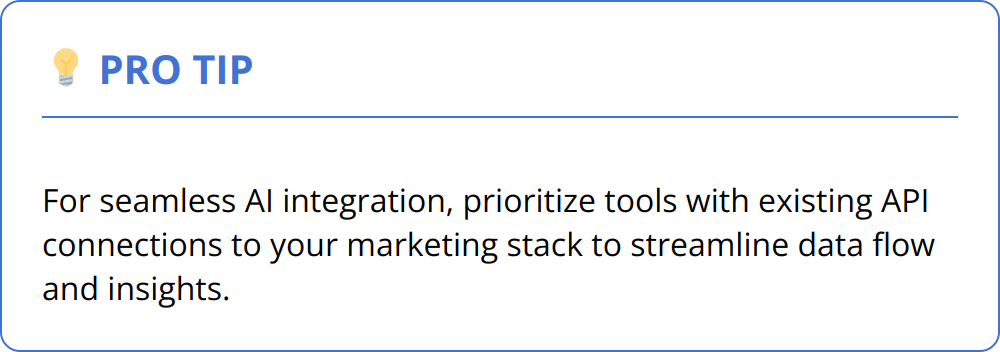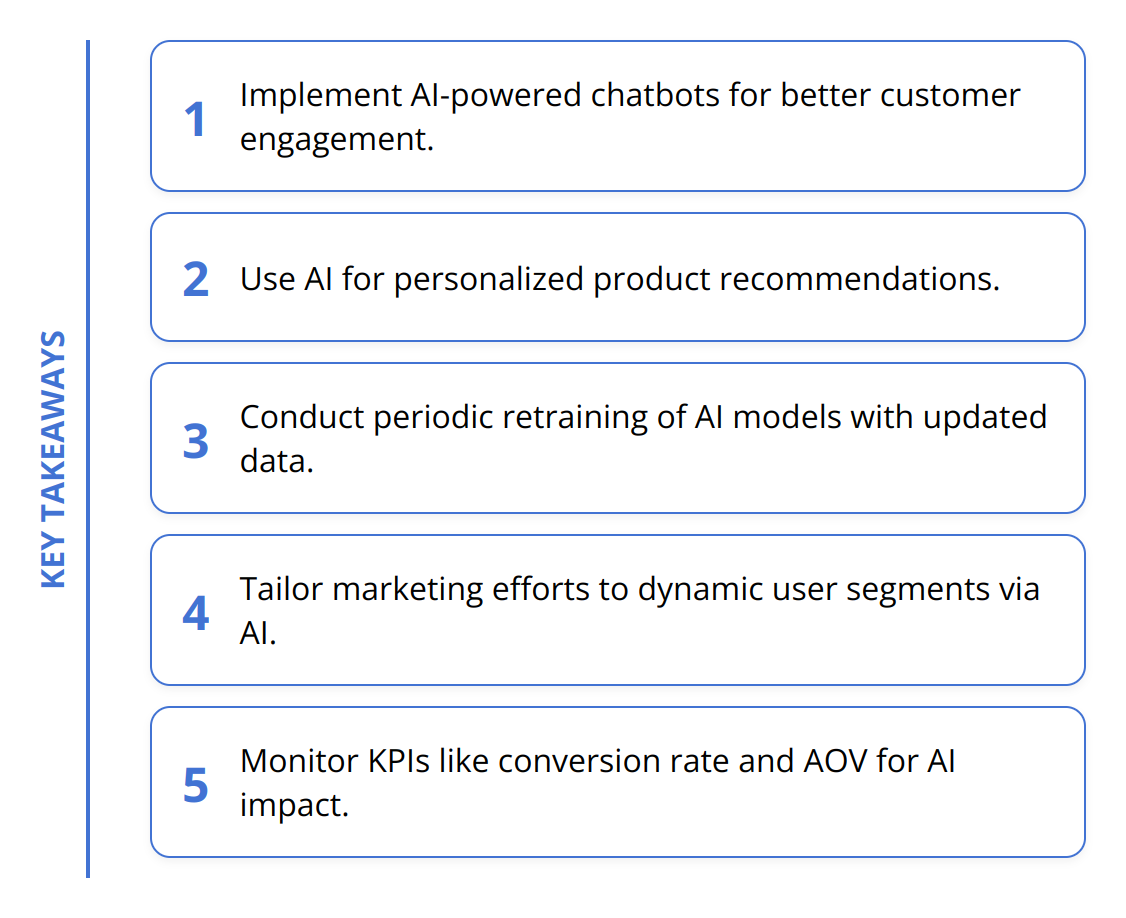Business-to-consumer (B2C) markets are intensely competitive, making conversion optimization more important than ever. Artificial intelligence (AI) is changing the game by enabling more effective strategies to enhance conversion rates. We at Emplibot believe that understanding and implementing AI in conversion optimization can significantly boost your business’s performance. This blog post explores the best practices for leveraging AI to optimize your B2C conversions.
Contents
ToggleElevating B2C Conversions with AI
In the bustling digital marketplace, standing out to consumers is no small feat. Businesses need to harness every technology at their disposal to make an impact, and artificial intelligence (AI) is at the forefront of this innovation. Let’s dive into how AI is reshaping B2C conversion optimization and why it’s a game-changer compared to traditional methods.
AI doesn’t just improve conversion rates; it revolutionizes the approach to understanding consumer behavior and personalizing their experience. With AI, businesses can analyze vast amounts of data in real time, identifying patterns and insights that were previously invisible. This means you’re not guessing what your customers want; you’re given a detailed map to their preferences and behaviors.
Key Areas Where AI Makes a Difference:
-
Personalized Recommendations: Unlike static algorithms, AI can predict customer preferences with astonishing accuracy, leading to highly personalized shopping experiences. This is not just a small step up from traditional methods; it’s a quantum leap.
-
Dynamic Pricing: AI can adjust prices based on demand, competition, and customer behavior, ensuring that your offerings are always competitively priced without sacrificing profit.
-
Chatbots for Enhanced Engagement: AI-powered chatbots provide real-time, personalized customer service, guiding users through their buying journey, which significantly boosts conversion rates.
Why AI Outperforms Traditional Methods:
Traditional analytics and manual adjustments can’t keep pace with the speed and complexity of today’s markets. AI’s ability to learn and adapt in real time means strategies are continuously optimized, ensuring that your business stays ahead of the curve.
-
Traditional methods rely heavily on broad market trends and historical data, whereas AI focuses on real-time insights and predictive analytics.
-
Manual personalization efforts cannot match the scale and accuracy of AI-driven personalized experiences.
-
AI tools automate and optimize tasks that would traditionally require extensive manpower and resources, from customer service to pricing strategy.

For businesses looking to stay competitive and attract more customers, integrating AI into your conversion optimization strategy isn’t just beneficial; it’s essential. The ability to understand and react to customer needs in real-time, with unprecedented precision, makes AI an invaluable tool in the B2C marketplace.
Here are actionable steps businesses can take today:
-
Implement AI-powered chatbots to improve customer interaction and satisfaction.
-
Leverage AI for personalized recommendations to enhance the customer shopping experience.
-
Use AI-driven analytics to fine-tune marketing strategies and identify emerging trends.

By integrating AI into your B2C conversion strategy, you’re not just keeping up with trends; you’re setting them. The potential for improved customer satisfaction and significantly higher conversion rates makes the adoption of AI not just strategic but, in many ways, indispensable for businesses aiming to thrive in the digital age.
For insights on creating converting content with AI, consider reading how to create converting content. This guide provides practical tips on leveraging AI for content that resonates with your audience, driving further engagement and conversions.
Best AI Implementation Practices
Maximizing B2C conversion rates using artificial intelligence requires more than just adopting AI; it demands a strategic and thoughtful approach. The effectiveness of AI in conversion optimization hinges on how well it’s integrated into existing marketing efforts, its continuous adaptation to new data, and its focus on providing personalized experiences to users.
Seamless Integration with Marketing Tools
The first step toward leveraging AI for conversion rate optimization (CRO) is ensuring it meshes well with your current marketing stack. The goal is to create a unified system where AI insights and capabilities enhance every aspect of marketing, from email campaigns to social media advertising. This integration allows for data to flow freely, ensuring AI can analyze information from all sources, providing a comprehensive understanding of consumer behavior.
Actionable Tips:
-
Conduct an audit of your current marketing tools to identify integration capabilities and potential gaps.
-
Select AI tools that offer APIs or direct integrations with your existing software to minimize disruptions.
-
Pilot AI implementations in phases, starting with areas where it can make the most impact quickly, such as personalizing email campaigns.

Continuous AI Model Training
AI models are only as good as the data they’re trained on, and this data changes constantly. Regularly updating your AI with new data ensures it remains effective in predicting customer behavior and optimizing conversion strategies. Continuous training allows AI to adapt to market trends, seasonal shifts, and evolving consumer preferences, keeping your conversions high.
Actionable Tips:
-
Set up a schedule for periodically retraining your AI models with fresh data.
-
Monitor performance metrics closely to identify when models may need retraining.
-
Use A/B testing to compare pre- and post-training performance, validating the effectiveness of updated models.
Prioritizing Personalization
Personalization is at the heart of converting modern consumers. AI excels at analyzing vast datasets to cater to individual user preferences, behavior, and engagement history. By prioritizing personalization, businesses can significantly enhance the user experience, leading directly to improved conversion rates.
Uniform strategies no longer suffice. Consumers expect interactions tailored to their unique needs and interests. AI’s predictive capabilities enable you to anticipate what your customers want, even before they do, creating a pathway to enhanced loyalty and conversion.
Actionable Tips:
-
Use AI to create dynamic user segments based on behavior and engagement data.
-
Tailor content, offers, and communications to these segments for highly personalized marketing campaigns.
-
Implement AI-driven recommendation engines on your website to suggest products or content that aligns with user history and preferences.

For more insights on tailoring content with AI, see our guide on personalizing content.
By addressing these key areas, businesses can unlock the full potential of AI in boosting B2C conversions. Integrating AI seamlessly into your marketing tools, continuously training AI models with new data, and focusing on personalization are not just recommendations; they are necessities for businesses aiming to scale and succeed in the competitive digital marketplace.
Measuring AI Impact on B2C Conversions
Effectively leveraging AI in B2C conversion optimization demands not just implementation but also precise measurement of its impact. Quantifying the effects of AI initiatives on conversion rates ensures that investments are driving desired results and informs strategy adjustments. Here, we’ll explore how to monitor key performance indicators (KPIs), utilize tools for accurate measurement, and interpret AI-driven data for continual improvement.
Key Performance Indicators to Watch
For businesses integrating AI into their conversion optimization strategy, monitoring specific KPIs is essential. These KPIs offer insight into the effectiveness of AI tools and initiatives:
-
Conversion Rate: A direct indicator of success. Any increase signals that your AI optimizations are resonating with consumers.
-
Average Order Value (AOV): AI’s role in personalizing product recommendations can significantly affect the AOV as customers find products more aligned with their interests.
-
Customer Lifetime Value (CLV): An increase in CLV can be attributed to better personalization and customer engagement, signaling effective AI utilization.
-
Bounce Rate: AI-enhanced site experiences should lower bounce rates as content becomes more relevant to visitors.
-
Cost per Acquisition (CPA): Efficient AI applications can reduce CPA by targeting and converting prospects more effectively.
Tools for Accurate Measurement
Leveraging the right tools is pivotal in accurately measuring the impact of AI on conversion rates. Tools and platforms offering detailed analytics and the ability to segment data are critical for drawing actionable insights. Consider using platforms such as Google Analytics for comprehensive website performance analysis and AI-specific tools for deeper insights into customer behavior and predictive analytics.
-
Google Analytics: Offers a broad overview of website performance, including user behavior, conversion data, and the success of personalization efforts.
-
AI Analytics Platforms: Specialized tools provide deeper insights into the effectiveness of AI-driven recommendations, chatbots, and pricing strategies.
For more in-depth AI analytics insights, explore AI in digital marketing.
Analyzing and Interpreting AI-Driven Data
The data captured by these tools offers a goldmine of insights, but it’s the analysis and interpretation that truly unlock AI’s value in optimizing conversions. Here’s how businesses can approach this:
-
Compare Pre and Post AI Implementation Metrics: Establishing a baseline before AI integration and comparing it with post-implementation performance data highlights AI’s impact.
-
Segment and Analyze Customer Journeys: AI enables the segmentation of customer data in unprecedented ways. Analyzing these segments reveals which AI-driven initiatives are most effective.
-
Predictive Analytics for Future Strategy: Utilize AI’s predictive analytics capabilities to not just report on past and present but to forecast future consumer behavior, allowing for proactive strategy adjustments.
Key Takeaways
-
Continuously monitor a set of key performance indicators to gauge AI’s impact on conversion rates.
-
Use a combination of general and AI-specific analytics tools for comprehensive measurement and deeper insights.
-
Analyze AI-driven data in the context of customer journeys and predictive analytics to inform future optimization strategies.
By diligently measuring and analyzing the impact of AI on B2C conversions, businesses can refine their strategies, ensuring that AI investments contribute positively to overall conversion goals. This ongoing process of measurement, analysis, and adjustment paves the way for sustained, AI-driven success in the competitive B2C market.
Wrapping Up
As we’ve explored throughout this blog post, AI significantly enhances B2C conversion optimization, offering a suite of benefits that traditional methods simply cannot match. With its ability to provide deep insights into customer behavior, personalize the user experience in real time, and optimize pricing strategies dynamically, AI stands out as an indispensable tool for marketers looking to improve their conversion rates.

The future of marketing is unmistakably aligned with the further integration of AI technologies. Trends indicate a shift towards even more personalized consumer experiences and predictive analytics, enabling businesses to not only understand current customer needs but also anticipate future desires. This evolution will likely result in more sophisticated chatbots and AI-driven content creation tools that can further streamline the customer journey towards a purchase.
For businesses ready to harness the power of AI, the path forward involves embracing these technologies and integrating them into their digital marketing strategies. Such adoption is not just about keeping up with current trends but setting a foundation for sustained growth and competitive advantage in a rapidly evolving digital landscape.
We at Emplibot understand the importance of staying ahead in the digital marketing game. To support businesses in maximizing their online presence, Emplibot offers a unique solution that automates the creation of SEO-friendly articles for WordPress sites. This includes comprehensive keyword research, incorporating relevant images, and ensuring proper internal linking – all done automatically to save time and enhance your site’s performance. For a hands-off approach to building a vibrant, SEO-optimized blog, explore our services at Emplibot.
In conclusion, the integration of AI into B2C conversion optimization strategies presents an exciting frontier for businesses. By leveraging AI, companies can ensure they not only meet the ever-evolving expectations of their customers but exceed them, driving higher conversion rates and fostering lasting customer relationships. With the continuous advancement of AI technologies, now is the time to embrace these practices and position your business for future success.










 Rated Excellent 4.5
Rated Excellent 4.5